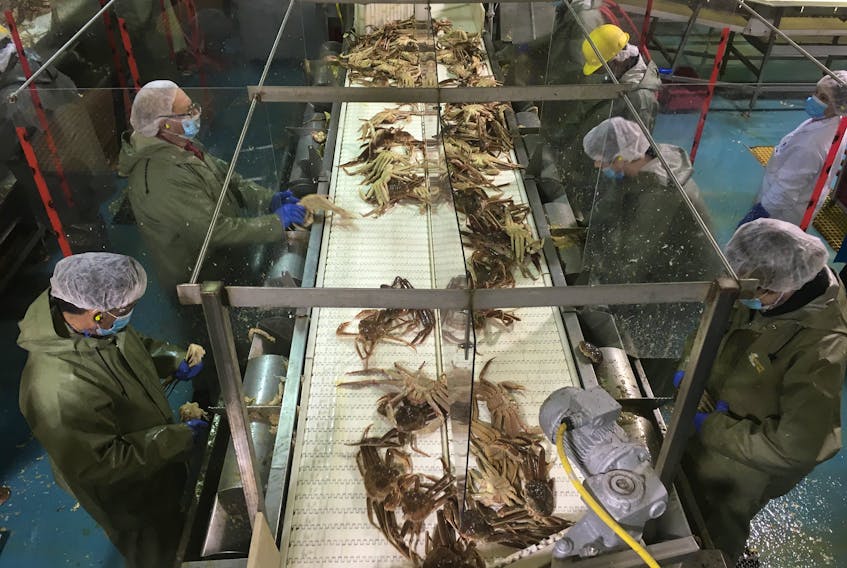Editor's Note: One year ago, our worlds changed. The first cases of COVID-19 struck in Atlantic Canada and the governments of P.E.I., Nova Scotia and Newfoundland closed businesses and put safety measures in place to keep people safe, which had a ripple effect on our livelihood and economy. This week, we’ll take a look back at how we lived, loved, worked, played and changed over the past year, and what lessons we’ve learned as we move forward.
If there’s one thing COVID has taught Atlantic Canada’s seafood processors, it's to be ready for anything.
That’s why Nova Scotia's Louisbourg Seafoods is installing new equipment at its plant in Canso to produce smaller packages of frozen shrimp for the supermarket aisle.
The change is a direct result of the pandemic, said company manager Allan MacLean.
As travel halted, resorts and restaurants closed down and cruise ships tied up, the traditional clientele for lobster and crab dinners disappeared.

Consumers still wanted seafood, but now they had to cook at home.
Companies had to pivot to create a product for that retail market.
“We actually did better in 2020 than we did in 2019 with our retail product,” he told SaltWire.
That wasn't a huge shift for Icewater Seafoods in Arnold’s Cove, NL. They were already supplying retail through their major customer, Mark’s and Spencer, in Britain.
“Our business is actually up because we’ve taken some new business focused on retail in Europe,” said owner Alberto Wareham.
“In the UK, our business is all retail; in France, it’s half retail and half food service.”
Fortunately, he said, the higher demand for retail in the UK helped buffer the foodservice collapse.
Atlantic Canada's new normal: A year of COVID-19
“We actually did better in 2020 than we did in 2019 with our retail product,” he told SaltWire.
For companies like Louisbourg Seafoods, with products traditionally destined for the foodservice market, it meant making bigger changes.
The company is adding freezing capacity at the plant in Louisbourg and is about two-thirds of the way through constructing a mussel processing facility in Englishtown to add retail packs to the production line.
“We have a lot of projects on the go and a lot of them are driven by the fact that . . . the markets have changed, and I don’t see them shifting back quickly,” said MacLean.
He says the changes they’re making will create a more flexible company.
They still hope for a return to the foodservice market as COVID vaccines roll out, but they’ll be able to shift to retail as well, serving consumer demand on two fronts.
Surprises

While COVID brought worry and huge challenges for the seafood business, it also produced some unexpected benefits.
There was no rubbing elbows or taste-testing at seafood trade shows in Boston or Europe in 2020. Zoom became a verb.
Atlantic Canada’s seafood producers replaced face-to-face meetings and in-person pitches to prospective buyers with video conference calls.
Wareham says meeting a new potential client is better done in person but many things can be done just as effectively online.
“That’s been a significant change for people in my type of position, where in my position where before I was travelling, sometimes every week,” added MacLean, who would normally spend a lot of time this time of the year attending DFO advisory meetings in Halifax.
For him, that meant a four-hour drive to and from his home base in Cape Breton.
“That’s a lot of lost work time. You’re in the car for over nine hours.”
He says he can do without that.
"(I) hope that the bulk of the meetings that I attended face-to-face before will be virtual.”
Derek Butler, executive director of the Association of Seafood Producers (ASP) in Newfoundland and Labrador, says the post-COVID world will likely be a combination of both virtual meetings and face-to-face events.
In-person meetings are still important, he said.
“Besides the structured meeting, it’s the side conversations, the chats during breaks, where you sometimes get information or learn something new. And that’s valuable,” he said. “So I don’t think the face-to-face meetings will go away entirely, but I think there’ll be more of a mix of both.”
Post-COVID

A year ago, MacLean, Wareham, and others in the seafood industry were busy shopping for masks and personal protective equipment, installing Plexiglass barriers, and figuring out the rules and regulations for operating in a pandemic.
The costs were, and still are, substantial.
Wareham, who operates just one processing plant with about 300 workers, says he’ll spend about $250,000 this year on PPE, cleaning supplies, and a half-dozen workers to clean high-touch areas in the plant and screen employees daily for COVID symptoms.
Multiply that cost over several facilities, and the price tag is enormous. And that’s a cost that may not go away soon, if at all.
Meanwhile, COVID has led to more cooperation and communication within the industry.
MacLean said in the early days of the pandemic, processors in Nova Scotia quickly realized the importance of teaming up to source PPE.
He was spending hours on the phone each day, trying to find masks and PPE for workers, items that were in high demand and sometimes short supply.
Business owners quickly began to share supplies or information on where to find the best deals on masks and hand sanitizer.
Through the Nova Scotia Seafood Alliance, he added, processors have developed a strong relationship with the province’s Public Health department. In January, for instance, Chief Medical Officer Dr. Robert Strang joined the group on a conference call to talk about expectations and answer any questions about health protocols for the 2021 season.
Previously, everyone worked the same 7:30 a.m. to 4 p.m. and took their lunch and dinner breaks at the same time.
Now, half the workers start their day at 7 a.m. and work until 3:30 p.m. and the other half work from 7:30 a.m. to 4 p.m.
At Icewater Seafoods, they had a little more time to prepare since the plant was shut down for maintenance in early 2020 and workers weren’t due to return until mid-May.
However, Wareham was in the middle of a major expansion project — installation of a state-of-the-art refrigeration system.
“We had about 20 different contractors here from late February until June getting that done. We also had to bring in people from Iceland to get the system fine-tuned and commissioned,” he said.
With the new rules on social distancing and travel, the anxiety level was high, he said, and workers were still worried about returning to the workplace.
He said the company not only communicated with workers ahead of their return-to-work dates but initiated a flexible work schedule to accommodate social distancing and a safe workplace.
“Our plant was built in 1979, long before the social distancing guidelines,” said Wareham. “In our lunchroom and our change rooms, you cannot meet the social distance guidelines with all the people you would have on a shift.”
The solution was to adjust the workday.
Previously, everyone worked the same 7:30 a.m. to 4 p.m. and took their lunch and dinner breaks at the same time.
Now, half the workers start their day at 7 a.m. and work until 3:30 p.m. and the other half work from 7:30 a.m. to 4 p.m.
Breaks are rotated, so there are only 30 people on break at one time.
Wareham says based on feedback from the workers, this schedule will likely remain in place even after COVID.
The lesson from the recent lockdown in his province, he said, is “don’t let your guard down.”
That means following the COVID protocols and wearing masks for some time to come.
While 2021 continues to bring COVID challenges — the foodservice industry is still depressed in most of the world — seafood processors in Atlantic Canada have proven resilient.
COVID is no longer unknown territory, they’ve conquered the protocols, pivoted as needed and continue to focus on the main business of producing seafood products for the world.
Top takeaways
Challenges
• Personal protective equipment - Sourcing masks and other PPE was challenging. Costs kept fluctuating
• Markets - The food service industry, which generally pays the best prices for seafood, all but disappeared.
• Marketing - COVID cancelled seafood shows, eliminating the opportunity for face-to-face pitches of products to potential new buyers.
• Costs - Installation of Plexiglass, PPE equipment, and installation of new production equipment to serve retail markets added to operating costs in 2020.
Surprises
• Zoom - Virtual conferencing provided an easier, more cost-effective way for business-to-business communication.
• New markets - Installation of equipment to serve the retail market means companies have become more able to feed consumer demand in both retail and food service markets.
• Safer workplace - Measures taken during COVID have created safer, cleaner workplaces. Bonus side effect has been reduction of lost time due to employee illness.
• Collaboration - COVID prompted more communication and sharing of information among seafood processors to resolve the common challenges like sourcing PPE.
• Long-term flexibility - The necessity to change because of COVID, like adding equipment for retail packaging, enable companies to be nimble in the future to serve markets.









